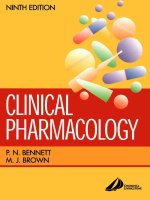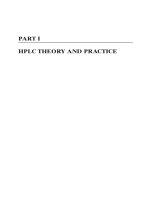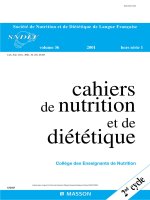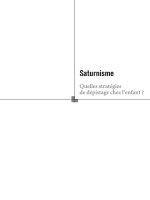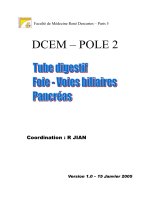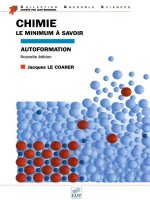Gastroenterology an illustrated colour text - part 1 doc
Bạn đang xem bản rút gọn của tài liệu. Xem và tải ngay bản đầy đủ của tài liệu tại đây (1.66 MB, 13 trang )
Gastroenterology
Commissioning Editor:
Laurence
Hunter
Project
Development Managers:
Jim
Killgore
and
Lynn Watt
Project
Manager: Nancy Arnott
Designer: Sarah Russell
Page
Layout:
Archetype
Graphic
Communication,
Peebles
AN
ILLUSTRATE
Graham
P.
Butcher
Consultant
Physician
and
Gastroenterologist
Southport
District General Hospital,
UK
Illustrated
by
Robert
Britton
CHURCHILL
LIVINGSTONE
EDINBURGH
LONDON
NEW
YORK
PHILADELPHIA
ST
LOUIS SYDNEY
TORONTO
2003
Gastroenterology
AN ILLUSTRATED COLOUR TEXT
IV
CHURCHILL LIVINGSTONE
An
imprint
of
Elsevier Science Limited
©
2003 Elsevier Science Limited.
All rights
reserved.
The right of
Graham
P.
Butcher
to be
identified
as
author
of
this work
has
been asserted
by him in
accordance
with
the
Copyright, Designs
and
Patents
Act
1988.
No
part
of
this publication
may be
reproduced, stored
in a
retrieval
system,
or
transmitted
in any
form
or by any
means, electronic,
mechanical, photocopying, recording
or
otherwise, without either
the
prior permission
of the
publishers
or a
licence permitting restricted
copying
in the
United Kingdom issued
by the
Copyright Licensing
Agency,
90
Tottenham Court Road, London
WIT
4LP. Permissions
may
be
sought directly
from
Elsevier's Health Sciences Rights Department
in
Philadelphia, USA: phone (+1)
215 238
7869, fax: (+1)
215 238
2239,
e-mail:
You may
also complete
your
request on-line
via the
Elsevier Science homepage
(),
by
selecting 'Customer Support'
and
then
'Obtaining Permissions'.
First published 2003
ISBN
0443
06215
3
British Library
Cataloguing
in
Publication
Data
A
catalogue record
for
this book
is
available
from
the
British Library
Library
of
Congress
Cataloging
in
Publication
Data
A
catalog record
for
this book
is
available
from
the
Library
of
Congress
Note
Medical knowledge
is
constantly changing.
As new
information becomes
available, changes
in
treatment, procedures, equipment
and the use of
drugs become necessary.
The
authors
and the
publishers have taken care
to
ensure that
the
information given
in
this text
is
accurate
and up to
date.
However, readers
are
strongly advised
to
confirm that
the
information,
especially with regard
to
drug usage, complies with
the
latest legislation
and
standards
of
practice.
ELSEVIER
your
source
for
books,
journals
and
multimedia
in
the
health sciences
www.elsevierhealth.com
The
publisher's
policy
is to use
paper
manufactured
from
sustainable forests
Printed
in
China
The
object
of
this book
is to
approach gastroenterology
in the
way
that patients present, rather than
in
traditional organ based
physiology
and
pathology. Both approaches have drawbacks,
and
diseases
do not
necessarily
fit
cleanly into either grouping.
We
have attempted
to
cover topics
in
two-page 'learning units'
but
of
necessity some require more extensive coverage
and
this
has
been given.
In
keeping with other books
in
this
series,
the
format
uses individually designed double page spreads, gener-
ously
illustrated with photographs, line drawings
and
tables.
Summary boxes reinforce important concepts
and act as
revi-
sion aids.
The
text
is
aimed
at
medical students, junior hospital doc-
tors, general practitioners
and
specialist nurse practitioners
in
gastroenterology.
The
text labours
the
importance
of the
history
and
examination
in
clinical practice because, despite huge
advances
in
investigations
and
particularly
in
imaging, these
are
the
cornerstone
to
effective
management.
G.P.B
ACKNOWLEDGEMENTS
I am
indebted
to my
colleagues
at
Southport
Hospital
for
help
in
preparing text
and
figures:
Mr
Mike Zeiderman
for the
sec-
tions
on
surgery;
Dr
Steve Dundas
for
pathology;
and Dr
Peter
Hughes
for
radiology images.
I am
grateful
to Dr
Howard
Smart
for
reading
and
checking
the
text.
The
book
is
dedicated
to
Deborah, Rhiannon
and
Verity.
G.P.B
PREFACE
vi
CONTENTS
History
2
Examination
4
Standard investigations
I 6
Standard
investigations
II 8
The
clinical approach
10
Cancer
of the
oesphagus
12
Disorders
of the
distal oesophagus
14
Neurological
and
infective
causes
of
dysphagia
16
The
clinical approach
18
Gastro-oesophageal
reflux
disease
20
22
ABDOMINAL
PAIN
-
CHRONIC
The
clinical approach
22
Dyspepsia
24
Peptic ulcer disease
26
Gastric tumours
28
Gallstones
30
Irritable bowel syndrome
32
Chronic pancreatitis
34
The
clinical approach
36
Acute pancreatitis
38
Acute
appendicitis/Diverticular disease
40
The
clinical approach
42
Coeliac disease (Coeliac sprue)
44
Ulcerative
colitis
I 46
Ulcerative
colitis
II 48
Ulcerative
colitis
III 50
Crohn's
disease
I 52
Crohn's disease
II 54
Infective
diarrhoea
56
Miscellaneous colitides
and
other causes
of
diarrhoea
58
Endocrine, post-surgical
and
lifestyle
causes
of
diarrhoea
60
The
clinical approach
62
Related conditions
64
THE CLINICAL APPROACH
INVESTIGATIONS IN GASTROENTEROLOGY
DYSPHAGIA
GASTROINTESTINAL CAUSES OF CHEST PAIN
ABDOMINAL PAIN - CHRONIC
ABDOMINAL PAIN ACUTE
DIARRHOEAL ILLNESSES
CONSTIPATION AND PERIANAL PAIN
The
clinical approach
66
vii
Iron deficiency anaemia
68
Lower gastrointestinal tract bleeding
70
68
The
clinical approach
76
Bilirubin
metabolism
and
liver
function
tests
78
Alcoholic liver disease
I 80
Alcoholic liver disease
II 82
Disorders
of
iron
and
copper metabolism
84
Inherited
and
infiltrative
disorders
86
Portal hypertension
I 88
Portal hypertension
II 90
Cholestatic liver diseases
92
Obstructive jaundice
94
Tumours
and
abscesses
of the
liver
96
Acute
hepatitis
98
Drugs
and the
liver
100
Chronic viral hepatitis
102
Autoimmune hepatitis
and
liver transplantation
Pregnancy
and
liver
disease
106
104
Normal nutrition
108
Index
111
ACUTE UPPER GASTROINTESTINAL HAEMORRHAGE
CHRONIC GASTROINTESTINAL BLEEDING
JAUNDICE AND LIVER DISEASE
NUTRITION
The
object
of
this text
is to
approach ill-
nesses
in the way in
which they present,
not
as
ready diagnoses
but
rather
as a
com-
plex
of
clinical symptoms with which
patients
may
suffer.
Consequently, some
illnesses could appear
in any one of a
num-
ber of
sections
but are
placed
at the
site
which seems appropriate
for
their common
presentation.
Gastroenterology, perhaps more than
any
other specialty,
has to
approach
the
patient
as a
whole
and not as
isolated sys-
tems. Many gastrointestinal (GI) illnesses
have extra-intestinal
or
extra-hepatic man-
ifestations
affecting
the
nervous system,
skin
or
joints. Conversely, many non-GI
conditions, such
as
thyroid, adrenal
and
cardiovascular diseases,
may
present with
symptoms referable
to the GI
tract.
This underlines
the
importance
of
a
systematic history
and
clinical examina-
tion prior
to
investigation.
HISTORY
OF THE
PRESENTING
COMPLAINT
Occasionally, abnormalities
are
picked
up
on
routine screening, such
as
anaemia
or
abnormal liver
function
tests,
but
usually
patients
are
symptomatic
and
present with
a
common range
of
symptoms.
DYSPHAGIA
The
usual description
is of
food
sticking
or
lodging
at any
site between
the
mouth
and
abdomen.
It is
helpful
to
determine
the
level
at
which food sticks,
the
duration
of
the
symptoms
and
also whether
it has
pro-
gressed
and
over what timescale. Previous
symptoms
of
gastro-oesophageal
reflux
suggest
a
peptic lesion whilst relentless
progression
and
weight loss point
to a
malignant cause.
ABDOMINAL PAIN
The
routine approach
to any
pain should
be
followed, with site, quality, duration,
behaviour (exacerbating
or
relieving fac-
tors) determined.
An
acute presentation
of
abdominal pain
is
often
due to a
perforated
or
inflamed organ
or an
intra-abdominal
vascular cause.
The
effect
of
food
and
defaecation should
be
elicited
for
more
chronic abdominal pain, whilst
a
relation-
ship
to the
menstrual cycle points
to a
Fig.
1
Buccal pigmentation
of
Peutz-Jeghers
syndrome.
gynaecological cause. There
are
often
associated symptoms
of
abdominal bloat-
ing
and a
change
in
bowel habit which
accompanies abdominal
pain
and
these
require specific inquiry.
CHANGE
IN
BOWEL HABIT
Constipation/diarrhoea
The
accepted normal range
of
stool fre-
quency
is
between three times
a day and
once every three days. Patients
are
often
embarrassed
to
discuss their bowel habit,
and
it is
important
to put
them
at
their ease.
It is
insufficient
to
accept descriptions
of
either constipation
or
diarrhoea alone.
The
frequency
and
consistency
of the
stool
should
be
determined,
and
prompting
may
be
helpful,
with descriptions such
as
'watery',
'porridge-like',
and
'hard'
or
'pellety'
(like rabbit droppings). Nocturnal
defaecation
and
urgency
are
important
symptoms
and
should
be
enquired about
specifically. Pale colour
and the
presence
of
oil
suggest malabsorption. Blood
in the
stool
can be
either mixed
in,
suggesting
a
higher colonic lesion,
or
seen discolouring
the
toilet water, which suggests
a
lower
colonic cause.
GI
BLEEDING/ANAEMIA
Iron
deficiency
anaemia
can be
caused
by
either chronic
GI
blood loss,
insufficient
dietary intake
or
malabsorption
of
ingested
iron. Blood loss
may be
noticed
in the
stool;
or
there
may be a
darkening
of the
stool, however
it is
usually unnoticed.
Specific inquiry should
be
made regarding
dietary intake
of
iron, particularly
red
meat,
and
evidence
of
malabsorption.
Acute
GI
bleeding
usually
results
in
haematemesis, melaena
or
frank
PR
(per
rectum)
bleeding accompanied
by
cardio-
vascular collapse when
sufficiently
large.
JAUNDICE
/
ABNORMAL LIVER
FUNCTION
TESTS
When taking
a
history
from
a
jaundiced
patient
it is
important
to
first
determine
whether
the
jaundice
is due to
cholesta-
sis/obstruction
or
not. Itch, pale stools
and
dark
urine
are
characteristic features
of
this. Specific questioning should include
recent
foreign
travel, prescribed medica-
tion within
the
last
6
months,
any
other
non-prescribed therapies
or
illegal drugs
taken ever,
with
particular reference
to
intravenous drugs. Previous blood
transfu-
sions,
episodes
of
jaundice
or
recent
con-
tact with jaundiced patients
and
sexual
contact (particularly homosexual) should
also
be
elicited. Family history
or
other ill-
nesses within
the
family
may be
important,
and
particular reference should
be
made
to
alcohol consumption, documenting daily
or
weekly consumption.
WEIGHT LOSS
The
importance
of the
history when deal-
ing
with
a
patient with weight loss cannot
be
overemphasised. Intake, absorption
and
metabolism should
be
considered.
Is a
patient
eating enough
to
maintain
an
ade-
quate
weight,
or is
there evidence
of an
eating disorder
or
other psychological ill-
ness such
as
depression? Recent onset
of
abdominal pain
or a
change
in the
nature
of
previous pain should alert
the
clinician,
whilst passage
of
pale stools with
oil in
them
(steatorrhoea) suggests malabsorp-
tion,
and a
change
in
bowel
habit
with
blood
in the
stools points
to a
colonic
cause.
A
complete review
of all
systems
is
essential,
as
respiratory, cardiovascular
and
endocrine causes
of
weight loss
can
lead
to GI
symptoms causing presentation.
PAST MEDICAL HISTORY
The
nature
of
previous surgery
is
often
poorly understood
by
patients,
but
attempts should
be
made
to
determine
what
has
been done previously
and
why.
There
may be a
recurrence
of the
previous
problem
or a
longer-term complication
of
the
surgery.
If
there
is
access
to
previous
medical notes then
it may be
helpful
to
HISTORY
know whether abnormalities
in
blood tests
(such
as
liver
function
tests) have been
long
standing.
FAMILY
HISTORY
This
is
obviously relevant
for
directly
inherited
disorders (Table
1 and
Fig.
1) but
is
also important
for
polygenic illnesses,
such
as
colitis, colon cancer
and
coeliac
disease, where having
affected
relatives
increases
a
patient's risk
of
developing that
condition.
Inquiry into where
the
family
has
come
from
may be
helpful,
as
certain
conditions
are
more prevalent
in
various
parts
of the
world, such
as
coeliac
disease
in
southern Ireland
and
intestinal tubercu-
losis
in
developing countries.
Knowledge
of the
mode
of
inheritance
and
relative
risks
will help
in
counselling
both patients
and
their families.
SOCIAL
HISTORY
Smoking habit, alcohol consumption
and
employment
may all
help
to
reach
a
diag-
nosis,
but
many
GI
conditions
are
chronic
and a
good knowledge
of
domestic cir-
cumstances,
family
life
and
hopes
and
expectations will facilitate managing
a
patient
long-term.
ALLERGIES
On
a
general note, patients
often
have mis-
conceptions regarding true drug allergies.
If
a
patient suggests they
are
allergic
to an
antibiotic,
the
exact circumstances
of
what
occurred should
be
clarified (e.g.
did
they
develop
a
rash?). Dietary intolerances
are
often
perceived
as
allergies and, again,
clarification
in the
history
is
required.
DRUG
HISTORY
Many
drugs
may
affect
the GI
tract
- not
only
drugs currently being taken
but
those
taken months previously (Fig.
2). All
drugs
should
be
treated with suspicion,
but
the
commonest
offenders
are
listed (Table
2).
If
there
is
doubt regarding
a
drug,
authoratative
texts
or the
manufacturers
should
be
consulted.
REVIEW
OF
SYSTEMS
It
is
quicker
to run
through
all the
systems
the
first
time
a
patient
is
interviewed than
to
realise
a
relevant
piece
of
information
was
missed
after
several
fruitless
investi-
gations.
Fig.
2
Medication
and
common complaints
that they
may
cause.
Gastric
ulcer.
Table
1
Some
of the
directly inherited diseases that
can
affect
the
gastrointestinal tract
Diseases
Inheritance
Liver
Wilson's disease
AR
Haemochromatosis
AR
Oesophagus
Tylosis
AD
Small
bowel
Peutz-Jeghers
syndrome
AD
Colon
Familial
adult
polyposis
AD
Hereditary non-polyposis colon cancer
AD
AR
=
Autosomal recessive;
AD =
Autosomal
dominant
Characteristics
Increased copper deposition
in
liver
and
brain
Increased iron deposition
in
liver,
skin,
pancreas
Hyperkeratosis
of
hands
and
squamous
cell
carcinoma
of
the
oesophagus
Pigmentation
of
buccal mucosa with hamartomatous polyps
in
small bowel
and
elsewhere
in GI
tract (Fig.
1)
Colonic polyps with high risk
of
malignant
development
Colorectal cancers
in
colonic adenomas, without polyposis
Table
2 A few of the
more common adverse effects caused
by
drugs
in the GI
tract
Site
Oesophagus
Stomach/duodenum
Small bowel
Colon
Liver
Drug
Antibiotics
Potassium slow release
NSAIDs
NSAIDs
Antibiotics
NSAIDs
Iron
Antibiotics
Paracetamol
Effect
Candidiasis
Mucosal ulceration
Gastritis/duodenitis
Ulceration/haemorrhage
Ulceration/haemorrhage
Pseudomembranous colitis
Colitis
Constipation
Cholestasis/hepatitis
Hepatitis
History
• A
thorough history
is
essential
in GI
medicine
as
many gastroenterological
conditions have systemic
effects
and
vice versa.
Tease
out
what patients mean
by
their descriptive terms such
as
'constipation'
or
'diarrhoea'.
Social circumstances
are
particularly important
in
managing patients with chronic
conditions well.
Current
medication
and
therapies taken within
the
last
6
months must
be
established
and
primary physicians should
be
contacted
if
necessary. Non-prescribed medication
and
drugs taken should also
be
determined.
Examination
of the
patient begins
as he or she
enters
the
consult-
ing
room,
and
continues whilst taking
the
history. This
is
also
true
when
clerking
a
patient
in the
accident
and
emergency department
-
much
can be
gained
from
the way the
history
is
given
and the
posture adopted.
Following
the
examination there
may be
obvious pointers
to
direct
further
investigations, such
as a
mass, lymph node
or an
enlarged
liver.
However, there
are
often
no
such clues
and
this
simply
emphasises
the
importance
of a
good history.
It
is
hopefully
clear that
a
complete physical examination
is the
ideal,
but it is not
possible
to
describe this here
and the
reader
is
referred
to
other texts.
The
following
will
outline
a
scheme
for
examination
of the GI
tract.
GENERAL
INSPECTION
The
presence
of
pallor
or
jaundice should
be
noted
and the
patient's general demeanour observed.
Difficulty
with
breathing
or
speech
and
concentration should
be
obvious,
and
abnormal
posture, such
as
that
due to a
hemiparesis, should
be
noted. Skin
should
be
inspected
for
rashes, such
as
erythema nodosum, pyo-
derma gangrenosum (Fig.
1) and
dermatitis herpetiformis,
and
joints should
be
examined
for
arthropathy.
HANDS
Look
for
finger
clubbing (Fig.
2),
leuconychia, koilonychia,
and
Dupuytren's
contracture
and
palmar erythema
in the
palms.
Patients should
be
requested
to
outstretch
their
arms
and
cock
their wrists back
to
check
for a
course flapping tremor
as
seen
in
hepatic encephalopathy. Pulse
and
blood
pressure must
be
mea-
sured.
NECK
AND
HEAD
The
neck should
be
examined
for
jugular venous engorgement,
a
goitre
and
lymphadenopathy. Mucous membranes
in the
mouth
should
be
noted
for
anaemia, pigmentation, aphthous ulceration
and
Candida;
the
tongue
for
glossitis
and
telangectasia;
the
teeth
for
damage
and
lips
for
angular stomatitis.
CHEST
WALL
This should
be
inspected
for
spider naevi
and (in
men)
the
pres-
ence
of
gynaecomastia.
ABDOMEN
Inspect
for
distension
and
previous surgical
scars,
and
note dis-
tended veins
- if
emanating
and
filling
from
the
umbilicus this
indicates portal venous obstruction (caput medusae). Employ light
palpation
for
tenderness, rigidity
or
guarding, observing
the
patient's
face
whilst examining, followed
by
firmer
palpation
for
masses (Table
1) and
then specific examination
for
enlarged liver,
spleen
and
kidneys.
If the
liver
is
enlarged
(Fig.
3) its
size
and
con-
sistency
should
be
determined
and
particularly
careful
examina-
tion
for
the
spleen performed (Table
2).
Percussion
of the
upper
Fig.
1
Pyoderma
gangrenosum.
border
of the
liver
is
important
to
determine
its
upper margin,
which
should
be in the fifth
intercostal space.
It may be
displaced
downwards
by a low
diaphragm,
as in
emphysema, which will
give
the
impression
of an
enlarged liver
if
only
the
abdomen
is
examined. Percussion
is the
only technique which will clinically
demonstrate
a
shrunken liver,
as
seen
in
cirrhosis.
Examine
for
shifting
dullness
or
fluid
thrill
for
ascites.
Auscultate
for the
quantity
and
characteristics
of the
bowel
sounds.
Anal
examination
for
haemorrhoids, mucosal prolapse,
tumours
and fistulae
should precede rectal examination which
examines both
the
mucosa
and
faeces
-
these should
be
inspected
for
colour
and
consistency
on the
glove.
Table
1
Differential
diagnosis
of
masses
in the
right
iliac
fossa
and the
epigastrium
Right
iliac
fossa
Caecal mass
-
tumour
or
faeces
Terminal
ileal
thickening
(Crohn's/TB)
Appendix
mass
Abscess
Ovarian tumour
Abdominal wall mass
Amoebiasis
Intussusception
Gastric tumour
Pancreatic tumour
or
cyst
Abdominal aortic aneurysm
Transverse
colon tumour
Abdominal wall mass
Table
2
Causes
of
hepatomegaly
Fatty
liver
-
smooth
and
firm
Hepatic tumour (primary
or
secondaries)
-
hard
and
irregular
Right ventricular failure
-
firm
and
smooth, possibly
pulsatile
Hepatic vein thrombosis (Budd-Chiari)
-
firm, smooth
and
tender
Myeloproliferative disorders
-
smooth
and
firm
Infective
(viral,
abscesses, hydatid cyst)
Storage
disorders (amyloidosts, Gaucher's,
haemochromatosis)
With
splenomegaly
Infective
-
infectious mononucleosis
Myeloproliferative
-
myelofibrosis, chronic myeloid leukaemia
Portal
hypertension
-
when associated with hepatomegaly
Storage
disorders (Gaucher's, amyloidosis)
Anaemia
(pernicious anaemia)
Sigmoidoscopy
This
is
usually only
helpful
when
the
rectum
is
empty.
It
allows
direct inspection
of the
rectal mucosa
for the
presence
of
colitis
and
also allows mucosal
or
lesion biopsy (Fig.
4).
However,
the
view
is
often
obscured
by
faeces
and
subsequent
flexible
sigmoi-
doscopic examination should
be
performed following
an
enema.
CLINICAL
GROUPINGS
The
experienced clinician seeks
out
certain combinations
of
signs
rather than simply examining
for all
possibilities.
Examples
include:
•
Stigmata
of
chronic
liver disease
(in the
jaundiced
patient)
which
include Dupuytren's contracture, gynaecomastia,
spider naevi
and
signs
of
portal hypertension which would
be
unusual
in an
acute liver disease.
•
Portal
hypertension
is
suggested
by
splenomegaly, ascites
and
caput medusae.
•
Hepatic
encephalopathy
is
suggested
by a
slow
flapping
tremor, foetor hepaticus
and
constructional apraxia.
•
Inflammatory
bowel disease
is
suggested
by
oral ulceration,
skin
rashes (pyoderma gangrenosum
or
erythema nodosum),
arthritis
and
iritis.
•
Primary
biliary
cirrhosis
is
suggested
by
jaundice,
xanthelasma
and
skin excoriation.
•
Eating
disorders
are
suggested
by
wasting, lanugo, abnormal
dentition associated with repeated vomiting
and
thickened
skin
on the
dorsum
of the
fingers
caused
by
repeated
self-
induced
vomiting.
EPONYMOUS
SIGNS
AND
'LAWS'
One way
that medicine honours
its
finest practitioners
has
been
to
name signs
or
diseases
after
those that described them. This
is
becoming less popular
but
here
are
some that
are
still
in
usage:
•
Murphy's
sign.
Pain
on
deep inspiration whilst
the
examining hand
is
placed below
the right
costal margin
is a
positive sign
and
suggests inflammatory gallbladder disease.
•
Grey Turner's
sign.
Extravasation
of
blood
from
haemorrhagic
pancreatitis
to
produce discoloration
in the
flanks
or
around
the
umbilicus (Cullen's sign).
•
Iroisier's
sign.
Palpable lymph node
in the
left
supraclavicular fossa (Virchow's
node)
associated
with
metastatic gastric cancer.
•
Courvoisier's
law.
A
palpable gallbladder
in the
presence
of
jaundice suggests that
the
jaundice
is
unlikely
to be due to
gallstones
and
pancreatic cancer
is
more likely (Mirizzi's
syndrome
- an
impacted stone
in the
cystic duct causing
partial obstruction
of
the
common hepatic duct
- is one
exception).
INVESTIGATION
Each section
in
this book features
an
investigation algorithm.
These help
to
formulate
an
investigation plan
but
cannot
be all
inclusive.
They
are led by a
good history
and
examination,
and
results
should always
be
interpreted
in
this light.
Fig.
3
Examination
of the
abdomen.
Fig,
4
Technique
of
Sigmoidoscopy.
Initial insertion
(A)
through
anus.
Advance
to B and
then
straighten
sigmoid
colon
by
advancing
to
position
C.
Examination
•
Inspection
of the
patient should begin when they
are
first
met and
continue
until
the end of the
clerking.
• A
full
general examination
is the
ideal.
• Do not
ignore clinical signs that
you may
imagine
do not fit
your
diagnosis.
Always
keep
an
open mind.
• If you
elicit
one
sign
of
chronic liver disease, specifically
search
for
others; likewise with portal hypertension, heart
failure,
malabsorption,
eating disorder, etc.
Fig.
2
Finger
clubbing.
ENDOSCOPY
Gastroscopy
(oesophago-gastro-
duodenoscopy
/
OGD)
(Fig.
1)
Indications
OGD is
usually
the
first
investigation
for
dysphagia, odynophagia, dyspepsia,
gastro-oesophageal
reflux
and
recurrent
vomiting.
The
procedure also allows inter-
ventions
such
as
biopsy, dilatation
of
stric-
tures, insertion
of
prostheses
for
palliation
of
malignant strictures,
injection
therapy
for
bleeding lesions
and
placement
of
gas-
trostomy tubes.
Technique
All
endoscopes
are
essentially similar with
a
flexible distal
tip
which
is
controlled
by
two
wheels allowing right,
left,
up and
down
movements. There
is an
operating
or
biopsy channel,
and a
separate channel
which passes
air to
distend
the
organ under
examination. Water
can
also
be
passed
down
this channel
to
wash
the
lens. Suction
can
be
applied
via the
operating channel.
Air/water
and
suction
are
controlled
by
blue
and red
buttons
on the
control head
(Fig.
2).
Following
a
period
of
fasting
(4-6
hours),
patients
are
placed
on
their
left
side
and
the
oropharynx
is
anaesthetised
by
top-
ical
anaesthetic.
The
patient
may or may
not
be
sedated,
depending upon preference.
Patient care during
the
procedure requires
maintenance
of the
airway
and
adequate
oxygenation.
Intubation
of the
oesophagus
is
usually
undertaken
under direct vision,
and
then
the
oesophagus, stomach
and the
duode-
num
to the
third part
are
inspected.
Careful
attention
is
paid
to
areas that
are
difficult
to
see, such
as the
gastric
fundus,
which
is
best seen
by
retroverting ('J'ing)
the
gas-
troscope.
Sedation.
The
usual
sedative
is an
intravenous
short-acting benzodiazepine
such
as
midazolam, which
has
both sedat-
ing
and
amnesic
effects.
The
principal
risk
of
sedation
is
suppression
of
breathing,
and
training
is
essential
to
allow
the
clinician
to
correctly titrate doses
- for
midazolam
doses range
from
2 mg for an
elderly
frail
women
or
child
to 10 mg or
occasionally
more
in a
large
man who may be
currently
using
a
benzodiazepine.
The
benzodiazepine receptor antagonist
flumazenil
allows rapid reversal
of the
Fig.
1
Gastroscopy.
effects
of
benzodiazepines,
and
should
always
be
immediately
to
hand
for
emer-
gency use.
Its
effects
take less than
a
minute,
and it
should
be
used when over-
sedation
has
occurred
and
breathing
has
been
suppressed.
Opiate analgesia, such
as
pethidine,
is
used
for
potentially
painful
procedures
such
as
colonoscopy
or
ERCP; however,
opiates compound
the
effects
of
benzodi-
azepines
and
their dose should therefore
be
reduced,
by
approximately 50%. Venous
access
is
best achieved with
a
cannula
in
the
right hand,
as
patients
lie on
their
left
and
in so
doing
may
impede venous
drainage
on
that side.
The
cannula should
only
be
removed when
the
patient
is
fully
awake.
Topical anaesthesia (lignocaine throat
spray)
is
usually
used
to aid
intubation
by
reducing
gagging. Patients
should
not be
allowed
to
drink
until
topical anaesthesia
has
worn
off and
should
not
drive
or
operate
machinery
for 24
hours
following
sedation.
If
a
procedure
has
been undertaken that
has
the
potential
to
perforate
the
oesopha-
gus,
patients should
be
examined
for
surgi-
cal
emphysema,
a
chest X-ray
can be
performed,
and if
symptoms
or
signs
are
suggestive,
a
gastrografin swallow should
also
be
carried out.
Potential
complications
•
Those
related
to
sedation.
•
Aspiration.
•
Those
related
to
specific procedures,
such
as
perforation
or
haemorrhage.
Obtain signed, informed consent
by
explaining
the
procedure,
the
possibility
of
sore throat following
it, and risks
associ-
ated with planned interventions.
Flexible
sigmoidoscopy
Indications
The flexible
sigmoidoscope
is
used
in the
investigation
of
rectal bleeding, rectal pain,
change
in
bowel habit
and
screening
for
colorectal cancer.
It
allows monitoring
of
ulcerative colitis,
and
should
be
performed
whenever
a
barium enema
is
requested.
Technique
Flexible sigmoidoscopy
is
often
performed
without
sedation.
The
patient's lower
bowel
is
prepared with
an
enema
and the
patient
is
placed
on his or her
left
side.
The
sigmoidoscope
is
introduced into
the
rec-
tum
following
a
digital examination
of the
anorectal canal
-
performed
to
avoid miss-
ing
lesions
of the
anal canal, which
may
not
be
well visualised during
the
proce-
dure.
A
view
is
usually obtained
to the
splenic
flexure.
Potential
complications
•
Those related
to
sedation
•
Those
related
to
specific procedures,
such
as
perforation
or
haemorrhage.
Obtain signed, informed consent
by
explaining
the
procedure, indicating that
if
a
polyp
is
seen this
may be
removed
at the
time. Explain that there
is a
very
low risk
of
perforating
the
bowel, particularly
if a
polypectomy
is
performed,
and
that
haemorrhage
may
occur
if a
biopsy
or
polypectomy
is
undertaken,
but
that this
usually
stops spontaneously.
